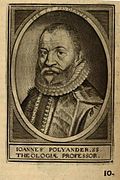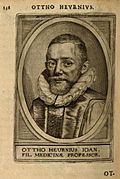 | |
| Illustrator | various artists |
|---|---|
| Language | Latin |
| Publication place | Netherlands |
Alma Academia Leidensis refers to an illustrated book about the professors of the University of Leiden, the Netherlands.
The most common version of the book Illustrium Hollandiae Westfrisiae ordinum alma academia Leidensis was published in 1614 and contained a series of engraved portraits of Leiden professors. Six versions were identified by the Amsterdam bibliographer Frederik Muller in 1888, that were published in 1609, 1613, 1614, 1617, 1715 and 1716. Muller made a list of the engravings and later J.F. van Someren made a concordance of the portraits from all the various editions, as some of the portraits were redone by later artists. Identifiable engravers were Crispijn van de Passe and Jan van de Velde.
- Illustris Academia Lugd-Batava id est Virorum Clarissimorum Icones, Elogia ac vitae, 1613
- Illustrium Hollandiae Westfrisiae ordinum alma academia Leidensis, 1614
- Other version from 1614
- Icones, Elogia ac vitae Professorum Lugdunensium apud Batavos - Andream Clouquium, 1617
The 1614 version included 5 "blank" engravings, possibly because the subjects had died before anyone could make their likeness, or because their likenesses were not ready in time for publication and book-buyers would be able to paste these in at a later date:
- frontispiece
- Cornelius Coninck
- Abrahamus ab Almonde
- Johannes Banchemius
- Johannes Grotius
- Cornelius Neostadius
- Adrianus a Mathenes
- Cornelius vander Myle
- Guliel Fevgueraeus
- Johannes Holmannus
- Cornelius Grotius
- Julius Beyma
- Everardus Bronchorstius
- Gerardus Tuningius
- Cornelius Pynacker
- Cornelius Swanenburch
- Johannes Linderhausen
- Everardus Vorstius
- Reynerus Bontius
- Paulus Merula
































































